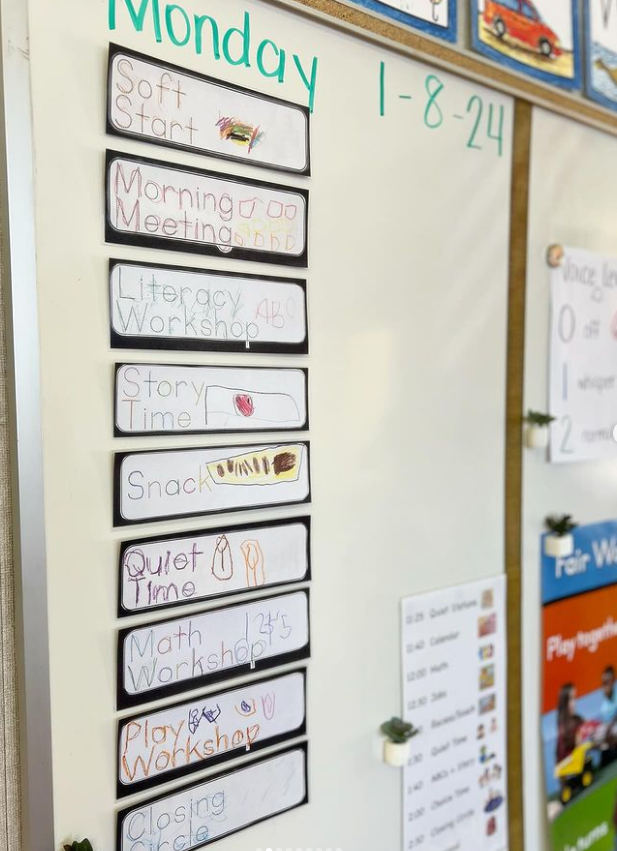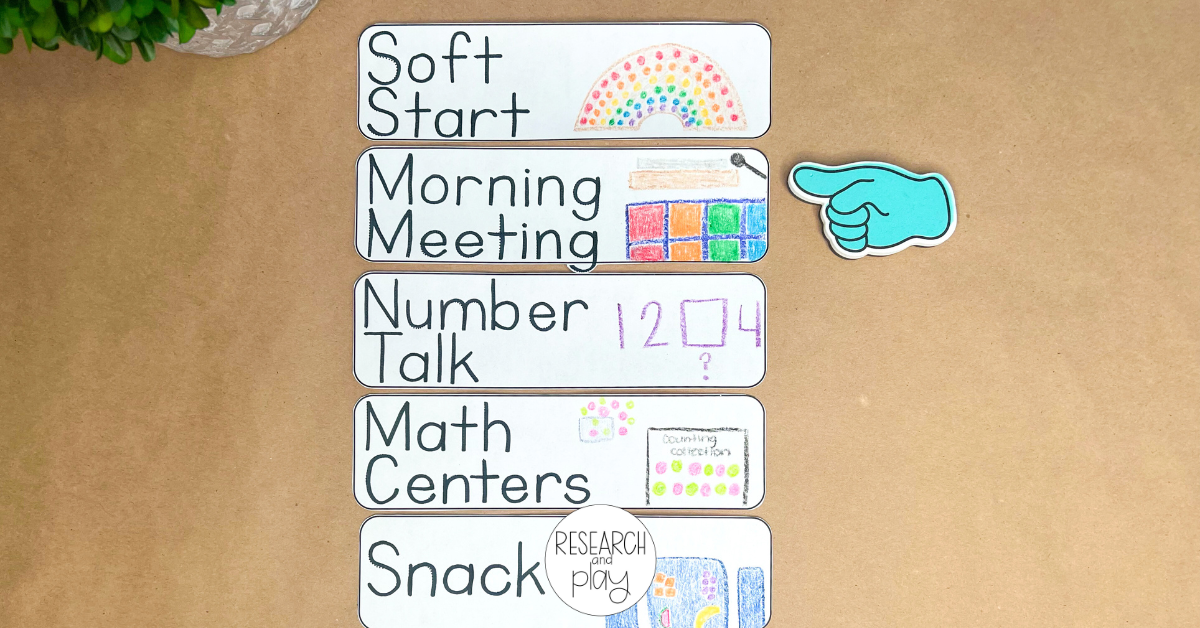“Can you talk more about your TK daily schedule?”
I get this question a lot! Whether I’m posting about workshop time, morning meeting, or play, people are always interested how we structure our day. I have needed a lot of trial and error, adjustments, and advice from colleagues to get two schedules that work well. I’ve taught both full-day and half-day programs, so I will break down both TK daily schedules. These schedules are what the day looks like by mid-year, but there are some adjustments I make early in the year to fit my students’ needs. I’ll detail those as well.
Full-Day TK Daily Schedule (5 hours):
- Morning Play/Soft Start – 20 minutes, using a specific set of materials including provocations and the morning play/soft start shelf
- Morning Meeting – 20 minutes, following the structure of Responsive Classroom with a movement break at the end
- Literacy Workshop* – 30 minutes, including a phonological awareness warm up, mini lesson (if needed), and small group time when groups work on one activity per day and rotate through all activities by the end of the week
- Story Time – 10 minutes, reading books either tied to our current inquiry or from Storyline Online
- Snack and Recess – 30 minutes, eating for the first 15 and playing for the next 15, would sometimes extend recess to 20-25 minutes
- Quiet Time – 10 minutes, watching either GoNoodle Flow videos or Cosmic Kids Yoga
- Math Workshop* – 30 minutes, including a number talk or math warm up, mini lesson (if needed), and whole group time focusing on one activity each day
- Flex Time – 15 minutes, could include another story, longer math time, or other activity
- Lunch and Recess – 40 minutes, eating for the first 20 and playing for the next 25 minutes
- Quiet Time – 10 minutes, listening to music and allowing students to quietly draw or look at books
- Inquiry – 30 minutes, focusing on any units of study you are in
- Play Workshop – 30 minutes, allowing students free choice of the play areas in the classroom
- Closing Circle and Pack Up – 15 minutes, including a reflection of the day, share out, and goal setting
*These blocks of time did not appear in our schedule until after Thanksgiving once students were a little older and ready for more developmentally-appropriate academic instruction and opportunities to practice those skills. Before Thanksgiving, the literacy workshop block was play workshop. Yes, we had two of those blocks! The math workshop block was just called workshop and could include any literacy or math concepts you wanted to introduce. This is when I did the name study and color study with my class. Now, with TK students getting younger, you may want to wait until after winter break before adjusting to literacy and math workshops.
Half-Day TK Daily Schedule (3 hours 20 minutes):
- Morning Play/Soft Start – 30 minutes, using a specific set of materials including provocations and the morning play/soft start shelf
- Morning Meeting – 15 minutes, following the structure of Responsive Classroom with a movement break at the end
- Workshop* – 40 minutes, combining both literacy and math skills and including a phonological awareness warm up, small group activities (could be focused on literacy or math), academic choice activities, and a share out
- Story Time – 15 minutes, reading books either tied to our current inquiry or from Storyline Online
- Snack and Recess – 30 minutes, eating for the first 15 and playing for the next 15
- Quiet Time – 10 minutes, watching either GoNoodle Flow videos or Cosmic Kids Yoga
- Inquiry – 15 minutes, focusing on any units of study you are in
- Play Workshop – 30 minutes, allowing students free choice of the play areas in the classroom (if no current inquiry, will extend to 45 minutes)
- Closing Circle and Pack Up – 15 minutes, including a reflection of the day, share out, and goal setting
*Workshop time in half-day TK combines both literacy and math skills. I will rotate between literacy small groups and math choice or vice versa. During small group time, both my IA and myself are working with groups while two other groups are working on their own. We rotate through activities weekly.

Frequently Asked Follow-Up Questions
Often times when I share details about our TK daily schedule, I will get follow-up questions. Here are some of the most common:
How do you choose small groups for your workshop time?
This depends on what I am working on. For some activities, I group students by fine motor ability if we are working early in the year on cutting, coloring, or pencil grip. For more literacy-focused activities, I may group by ability for those skills. Same goes with math, but I’ve found that math skills tend to be more similar at this age than literacy skills.
During play workshop, do you always let kids choose where they want to play?
Not always. Early in the year, I want to expose all children to all play areas. I will add their names to our play workshop chart and rotate them daily. Eventually I add a sign at each area that tells how many children can play there. Then my students are allowed to chose their own area. If it’s full by the time they get there, they have to go to their backup plan. Sometimes they are not ready for a backup plan, so they can read books and wait for their turn. I will sometimes be flexible and allow one more student into a space.
Do you do quiet time every day? Isn’t it hard to manage keeping them quiet?
Yes and yes! It’s a great practice for getting their minds and bodies settled from play. I talk to them a lot early in the year about the purpose of quiet time. I don’t expect silence for the entire quiet time, but we do talk about having a “zero voice” so that our bodies can rest. My students are allowed to lay down on the rug during this time and, in full-day TK, could get a stuffed animal to cuddle with. However, this can be more of a distraction than a support!
I feel like I never have time for something like closing circle because I’m rushed to pack up. How do you do it every day?
It’s a non-negotiable in my classroom. Even if it’s a quick, 5-minute closing we will still do it. This is when we reflect on the day as a group and individually. I always like to ask my students how their day was. If someone continuously gives me feedback that their day was bad, it’s an invitation to talk to them about anything bothering them. I can also hear their favorite parts of the day which I can use as feedback for the activities they enjoyed most. It allows us to have a structured, calm pack up time as well. It’s even when we do our clean up tasks! So for us, closing circle is a must.
More information:
If you teach kindergarten, I have many blog posts detailing my past daily schedules. Here is the most recent one: A Kindergarten Daily Schedule
To learn more about how I have organized my play areas in the past, see this post: How to Organize and Manage Play Centers
I get questions about what TK looks like for us in Southern California. I have now taught TK in two districts, and they are very different from one another. Check out this highlight on my Instagram page for some TK-specific FAQs.
One of the biggest supports for being able to have such a student-centered, play-based classroom is my use of the Responsive Classroom approach. To see my favorite RC books, click here.


